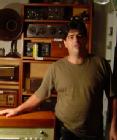emerson: Emerson 461
? emerson: Emerson 461
Count of Thanks: 7
Hello,
I have this radio. The cabinet appears the same as in your file under your heading emerson_461. My 461 cabinet is made of cardboard, not the listed Bakelite, with a thin "leatherette" covering. However, it also has a spring-loaded handle. The chassis inside has the tube lineup of Emerson 361. From the photos on the web site, the radio pictured there has the same kind of wear and indentations as mine. Are you interested in any photos of my example for comparison?
Bill Goodwin
To thank the Author because you find the post helpful or well done.
> Are you interested in any photos of my example for comparison?
This would be interesting.
> My 461 cabinet is made of cardboard, not the listed Bakelite
I believe this should be listed as a sub-model on its own page; perhaps a Moderator will assist with that.
> The cabinet appears the same ... My 461 cabinet is made of cardboard, not the listed Bakelite, with a thin "leatherette" covering.
> The chassis inside has the tube lineup of Emerson 361.
At the risk of speculating.....
1940 and 1941 Emerson sold 19%-25% of all radios in the US. BIG production.
1942, civilian use of military strategic materials was limited to support the war effort. This came fairly suddenly-- while the US government had considered entering the war for some time, the idea of requisitioning large portions of civilian production was radical.
Radio parts and Bakelite were obvious military needs. Radio had been considered strategic in WWI, and more so with the much improved radios of the 1940s.
I speculate that Emerson introduced "new for '42!" models, produced some 461s in Bakelite, and then the Bakelite company stopped supplying to civilian uses. Meanwhile Emerson had a supply of assembled chassis, standing orders for radios, and a tight market offering full profit. And any large radio maker had some stock of cardboard and leatherette. And these assembled chassis and cardboard were in the way of clearing the factory to make military radios. And it would be good to have a few more radios in civilian hands as long as it did not hurt military production, which did not start immediately. So Emerson (perhaps with approval from the government) quickly put the existing chassis in cardboard with 461 styling.
It might be interesting to know if Emerson included any "wartime shortage" note on the radio or the original packaging. Books printed in this period sometimes had such a note.
> the tube lineup of Emerson 361
That tube line-up was common on many radios of the period. And in the late 1930s the same chassis might run for several years with a different case each year. In the war shut-down, Emerson might have used any or all chassis they had in stock. Performance would be nearly identical, and customers had no choice.
We'd need better info on both 461 and 361 to guess if the cardboard 461 was 461 chassis, 361 chassis, or if 461 and 361 are the same chassis.
However the existence of cardboard case when Bakelite was "normal" for low-price table radios is an interesting bit of histric trivia.
To thank the Author because you find the post helpful or well done.
Emerson model 461

To thank the Author because you find the post helpful or well done.
Two different variants for the cabinet?
I wondered if we have members who own an Emerson model 461 with a Bakelite cabinet.
The first answer I became from our member Vitorio Emanuele Sartori and I thank him herewith. His answer is:
HELLO ERNEST,
I CONFIRM MY RADIO IS MADE BY PRESSED CARDBOARD, NOT MASONITE O BAKELITE OR WOOD.
THE TUBES ARE: 12SA7 12SK7 12SQT 50L6 AND 35Z5 AND A LAMP 47 FOR DIAL.
I have now added the tube line-up as the chassis-picture from Carlos Lazarini shows clearly: 12SA7, 12SK7 (metal), 12SQ7 (metal), 50L6GT and 35Z5GT. We don't distinguish models which emplay GT-types from metal types, because it is a matter what one puts in - but for an other tube line-up we would create an other model page and do crosslinks.
If the "speculation" of Paul Reid is reality - thank you for the thoughts - then we should hopefully find sets with a bakelite case. In that case we will duplicate the model page and link them together.
I wrote a small article about Emerson Radio "American Five Family" 1939 to 1942 which I will later link to all these models concerned. At the moment it is attached (sticky) for Emerson model EL-361 and linkted only from Emerson model DB-301, the first of the list.
I hope we get more information - and once a basic article for the history of the AA5 in total. This history began in season 1933/1934 with the tube 6A7 and a corresponding series for car radios, soon combined with the rectifier 25Z5 for cheap home radios. This season starts the AA5 as a transformerless AC/DC-Radio (with a "hot" chassis). Transformerless is for me the point - but AA5 with transformers started much earlier, even as TRF (tuned radio frequency). But see here a typical transformerless early AA5 from Kennedy - for which we have not really a model designation.
Your suggestions are also welcome via the bottom link "Contact", present on each page.
To thank the Author because you find the post helpful or well done.
